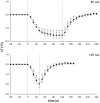The direct cooling of the preoptic-hypothalamic area elicits the release of thyroid stimulating hormone during wakefulness but not during REM sleep
- PMID: 24498374
- PMCID: PMC3911997
- DOI: 10.1371/journal.pone.0087793
The direct cooling of the preoptic-hypothalamic area elicits the release of thyroid stimulating hormone during wakefulness but not during REM sleep
Abstract
Thermoregulatory responses to temperature changes are not operant during REM sleep (REMS), but fully operant in non-REM sleep and wakefulness. The specificity of the relationship between REMS and the impairment of thermoregulation was tested by eliciting the reflex release of Thyrotropin Releasing Hormone (TRH), which is integrated at hypothalamic level. By inducing the sequential secretion of Thyroid Stimulating Hormone (TSH) and Thyroid Hormone, TRH intervenes in the regulation of obligatory and non-shivering thermogenesis. Experiments were performed on male albino rats implanted with epidural electrodes for EEG recording and 2 silver-copper wire thermodes, bilaterally placed in the preoptic-hypothalamic area (POA) and connected to small thermoelectric heat pumps driven by a low-voltage high current DC power supply. In preliminary experiments, a thermistor was added in order to measure hypothalamic temperature. The activation of TRH hypophysiotropic neurons by the thermode cooling of POA was indirectly assessed, in conditions in which thermoregulation was either fully operant (wakefulness) or not operant (REMS), by a radioimmunoassay determination of plasmatic levels of TSH. Different POA cooling were performed for 120 s or 40 s at current intensities of 80 mA and 125 mA, respectively. At both current intensities, POA cooling elicited, with respect to control values (no cooling current), a significant increase in plasmatic TSH levels in wakefulness, but not during REMS. These results confirm the inactivation of POA thermal sensitivity during REMS and show, for the first time, that this inactivation concerns also the fundamental endocrine control of non-shivering thermogenesis.
Conflict of interest statement
Figures


References
-
- Parmeggiani PL (2011) Systemic homeostasis and poikilostasis in sleep. London: Imperial College Press. 121 p.
-
- Morrison SF, Blessing WW (2011) Central nervous system regulation of body temperature. In: Llewellyn-Smith IJ, Verbene AJM, editors. Central Regulation of Autonomic Functions. New York: Oxford University Press. pp.324–344.
-
- Parmeggiani PL, Franzini C, Lenzi P, Zamboni G (1973) Threshold of respiratory responses to preoptic heating during sleep in freely moving cats. Brain Res 52: 189–201. - PubMed
-
- Glotzbach SF, Heller HC (1976) Central nervous regulation of body temperature during sleep. Science194: 537–539. - PubMed
-
- Florant GL, Turner BM, Heller HC (1978) Temperature regulation during wakefulness, sleep and hibernation in marmots. Am J Physiol 235: R82–R88. - PubMed
Publication types
MeSH terms
Substances
LinkOut - more resources
Full Text Sources
Other Literature Sources

